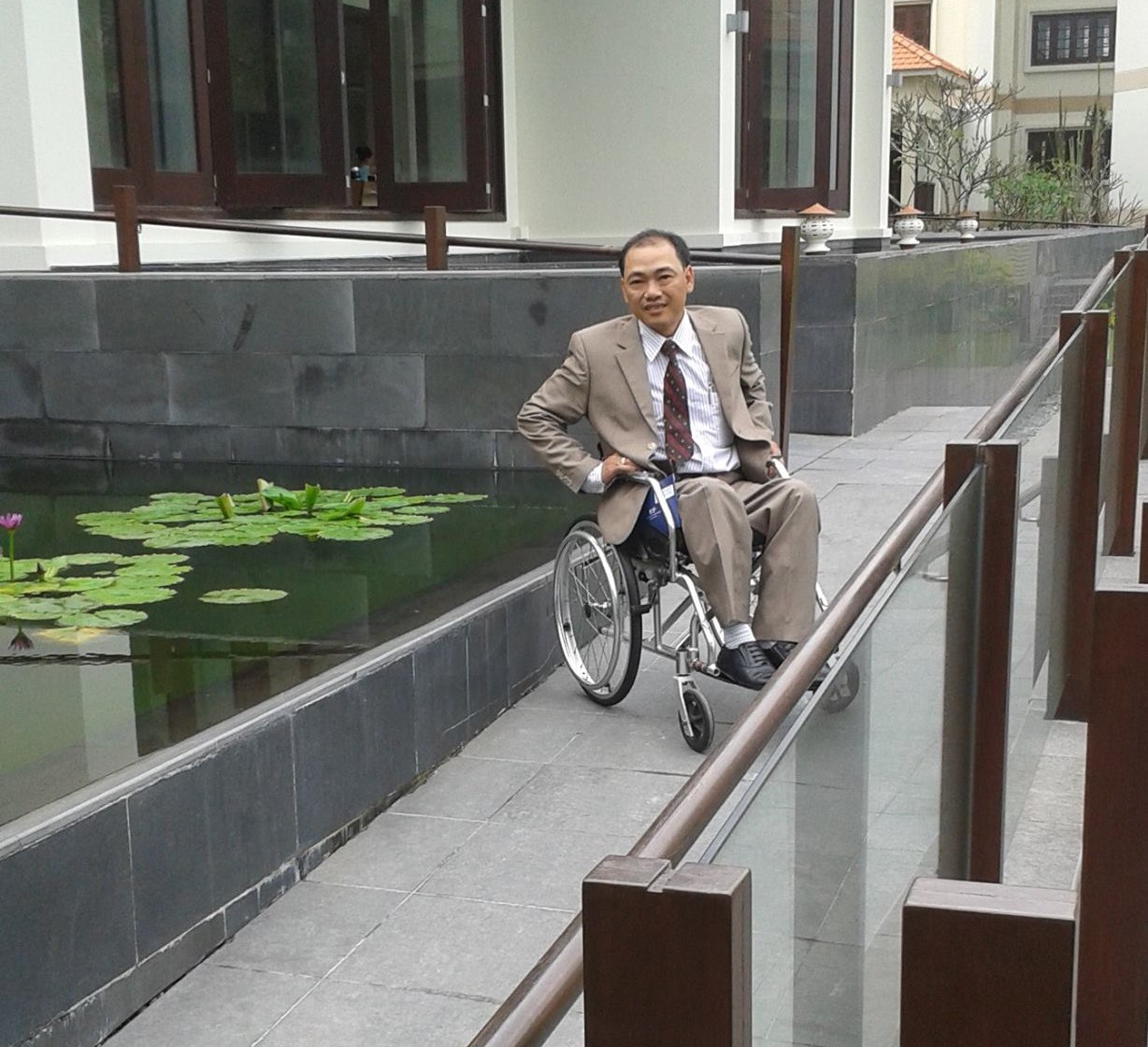Building barrier-free environment for the disadvantaged
Da Nang is one of the pioneering Vietnamese cities in developing infrastructure for people with disabilities. Many hotels, tourist resorts or beaches have designed wheelchair-accessible paths, thereby creating conditions for people with disabilities to enjoy entertainment services.
 |
| Chairman of the Da Nang Disabled People's Association Truong Cong Nghiem experiences wheelchair access at Pullman Danang hotel. Photo courtesy of Truong Cong Nghiem |
Go to sea with confidence
Before having a traffic accident that left her legs paralyzed, Ms. Nguyen Thi Thu Ha from An Hai Bac Ward, Son Tra District, Da Nang often went to the beach early in her daily routine as a good way to find peace and joy every day. However, the accident nearly 10 years ago forced her to give up this healthy habit, bringing with it self-deprecation and sadness for many years. Ha said, she used to consider her inability to go to the beach to be another pain after an accident. Fortunately, she heard that Da Nang administration’s instruction on opening a wheelchair-accessible path to the beach in 2016. At that time, the woman said with emotion: "It's really good news”.
Her "first" trip to the beach after many years of staying at home involved the enthusiastic company of relatives. From the small house on Nguyen Trung Truc Street, she drove her wheelchair along Do Anh Han and Vuong Thua Vu streets to reach Pham Van Dong Beach. Right in the Bien Dong (East Sea) Park, she found a way to the beach by wheelchair.
“The feeling at that time was a bit apprehensive, but I still wanted to try. I inched the car little by little to the safe line of the path and then released the brakes to let the car gently move down to the beach. It was a clear blue sky day, the sea breeze gently blowing on my face. I sat there, looking at the distant sea, feeling each gentle wave. I couldn’t set foot in the water, but for me, that was enough to be so happy”, Ms. Ha fondly recalled the first time she went to the beach after many years of staying at home with a wheelchair. From that day on, the sea became a place for Ms. Ha to re-discover the joy of life.
Understanding the wishes of disabled people like Ms. Ha, in 2020, the Da Namg People's Committee continued to approve the investment policy of the ‘paths to beached exclusively for people with disabilities’ project along 30 km of the city's coastline at a total expected investment capital of more than VND 10.9 billion from the city’s budget.
Under this project, there will be 18 walkways to tourist beaches along Vo Nguyen Giap, Hoang Sa and Truong Sa streets and 6 others along Nguyen Tat Thanh Street. In particular, these walkways help people with disabilities access the water's edge. The ramps are reinforced with concrete structures and have fiberglass floors installed on the sand to create access to the edge of the sea. In the first phase, the project will pilot the installation of stainless steel railings to support the disabled in accessing beach services.
According to Mr. Phan Minh Hai, the Deputy Head of the Management Board of Son Tra Peninsula and Da Nang Tourist Beaches, the current the project is expected to be implemented as soon as possible to create conditions for less fortunate people to bathe and enjoy the sea space. While waiting for the construction of new, more comfortable walkways, the city continues to maintain the existing ones with a length of 40m from the sidewalk to the water's edge located in the East Sea Park and the Vo Nguyen Giap - Hoang Ke Viem intersection.
Humanistic paths
Da Nang's efforts in developing infrastructure for people with disabilities have opened up opportunities for thousands of people with disabilities throughout the city. Roads, walkways and public buildings are designed to be wheelchair-friendly to help them be more confident when participating in outdoor activities.
Chairman of the Da Nang Disabled People's Association Truong Cong Nghiem recalled that in 2022, when Da Nang put the APEC Park into operation, he invited a group of disabled people to this new project. What impressed him when he came here was that the park had two wheelchair-accessible paths. “It is a big step forward in building a barrier-free city for all. Flat walkways not only help the disabled move easily but also bring a feeling of respect and companionship in daily life”, Mr. Nghiem said emotionally.
With green space and appropriate architectural design, the APEC Park has become an ideal venue for people with disabilities to participate in recreational activities, sports and meet friends. However, to make travelling safer, Mr. Nghiem wants more carefully-studied adjustments to the up and down entrances for disabled people here, regarding the slope level and width of the walkways.
Da Nang's efforts in building wheelchair-accessible pathways are an important step towards creating a safer and friendlier living environment.
In a similar vein, to better serve tourists, most new hotels built in over the past 5-7 years have areas designed specifically for people travelling in wheelchairs. In his perspectives, Mr. Cao Tri Dung, Chairman of the Da Nang Tourism Association, said that these walkways not only bring convenience but also show the city's care and respect for those with disabilities.
Also according to Mr. Dung, Da Nang always tries to create a friendly, barrier-free tourism environment. The fact that hotels in Da Nang such as Brilliant, Pullman, Furama and Wyndham Danang Golden Bay have built spaces for wheelchair access is part of effort.
“The fact that hotels in Da Nang focus on designing wheelchair-accessible pathways also reflects the city's progressive thinking in building an inclusive, respectful and barrier-free tourism environment. These human values make the city more beautiful and worth living, thereby promoting integration and sustainable development in the community.”, Mr. Dung concluded.
Reporting by HUYNH LE - Translating by A.THU